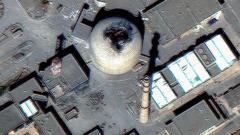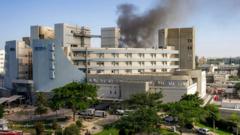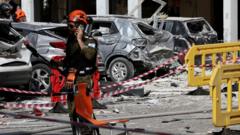Archaeologists fear significant cultural losses as Israeli airstrikes threaten Lebanon's historical sites, notably the Roman ruins at Baalbek.
Ancient Ruins Under Threat Amid Israeli Strikes in Lebanon

Ancient Ruins Under Threat Amid Israeli Strikes in Lebanon
The ongoing conflict raises alarms as archaeological treasures face potential destruction.
Baalbek, a UNESCO World Heritage site boasting extraordinary Roman architecture, is now at risk following an Israeli airstrike that targeted a nearby car park. The bombing last Wednesday also destroyed an Ottoman-era structure, prompting concerns from archaeologists about the safety of Lebanon’s historical treasures amid escalating military actions between Israel and Hezbollah.
Graham Philip, an archaeology professor from Durham University, emphasized the irreplaceable nature of Baalbek, stating, “It would be a huge loss. It would be a crime.” Since Israel intensified its military campaign against Hezbollah with thousands of airstrikes beginning late September, targeting primarily southern Lebanon and the capital, Beirut, archaeologists are increasingly worried about collateral damage to ancient sites.
Recent operations have led to bombing closer to Baalbek's temples and Tyre's ruins, significant locations tied to the Roman and Phoenician empires. The IDF claims that military targets are carefully selected, yet the proximity of these historical sites raises questions about their potential vulnerability. “No one knows what the excuse or the message behind the hit is,” commented Joanne Farchakh Bajjaly, a local archaeologist.
The IDF assured the public of precautionary measures when targeting areas close to sensitive sites. Nonetheless, the fear persists among Lebanese citizens who fled to Baalbek's ruins, mistakenly believing the ancient temples would provide them shelter from bombings.
Erez Ben-Yosef, an Israeli archaeologist, highlighted the paradox posed by the war, stressing the immense loss to cultural heritage should these sites be damaged. Ben-Yosef remarked on the efforts by military personnel, many of whom are also archaeologists, to avoid damaging historic sites during operations.
Despite the assurances, concerns about accidental strikes remain high. Graham Philip illustrated the unpredictability of bombings, suggesting that some munitions may miss their intended targets, putting valuable archaeological sites at risk. While the full extent of damage from recent conflicts in Lebanon and Gaza is still being assessed, UNESCO documented destruction of 69 cultural heritage sites in Gaza during the ongoing violent crisis, further linking warfare to the deleterious impact on historical landmarks.
The cultural identity tied to ancient sites, Philip noted, cannot be overstated. Losses to such significant artifacts resonate deeply within populations, akin to the destruction of iconic structures in Britain like the Tower of London, altering the very essence of their heritage and historical narrative.





















